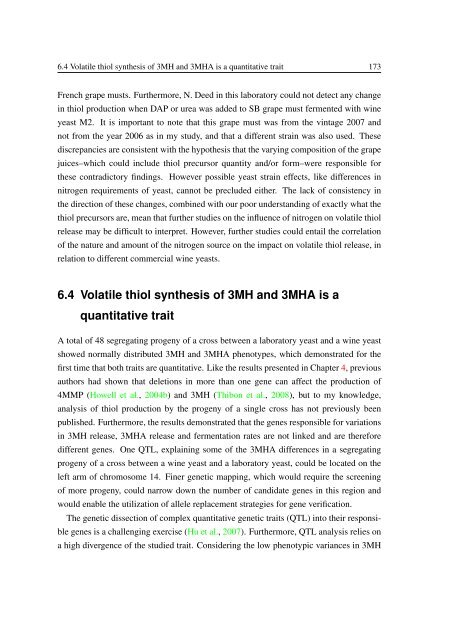Identification of yeast genes involved in Sauvignon Blanc aroma ...
Identification of yeast genes involved in Sauvignon Blanc aroma ...
Identification of yeast genes involved in Sauvignon Blanc aroma ...
You also want an ePaper? Increase the reach of your titles
YUMPU automatically turns print PDFs into web optimized ePapers that Google loves.
6.4 Volatile thiol synthesis <strong>of</strong> 3MH and 3MHA is a quantitative trait 173French grape musts. Furthermore, N. Deed <strong>in</strong> this laboratory could not detect any change<strong>in</strong> thiol production when DAP or urea was added to SB grape must fermented with w<strong>in</strong>e<strong>yeast</strong> M2. It is important to note that this grape must was from the v<strong>in</strong>tage 2007 andnot from the year 2006 as <strong>in</strong> my study, and that a different stra<strong>in</strong> was also used. Thesediscrepancies are consistent with the hypothesis that the vary<strong>in</strong>g composition <strong>of</strong> the grapejuices–which could <strong>in</strong>clude thiol precursor quantity and/or form–were responsible forthese contradictory f<strong>in</strong>d<strong>in</strong>gs. However possible <strong>yeast</strong> stra<strong>in</strong> effects, like differences <strong>in</strong>nitrogen requirements <strong>of</strong> <strong>yeast</strong>, cannot be precluded either. The lack <strong>of</strong> consistency <strong>in</strong>the direction <strong>of</strong> these changes, comb<strong>in</strong>ed with our poor understand<strong>in</strong>g <strong>of</strong> exactly what thethiol precursors are, mean that further studies on the <strong>in</strong>fluence <strong>of</strong> nitrogen on volatile thiolrelease may be difficult to <strong>in</strong>terpret. However, further studies could entail the correlation<strong>of</strong> the nature and amount <strong>of</strong> the nitrogen source on the impact on volatile thiol release, <strong>in</strong>relation to different commercial w<strong>in</strong>e <strong>yeast</strong>s.6.4 Volatile thiol synthesis <strong>of</strong> 3MH and 3MHA is aquantitative traitA total <strong>of</strong> 48 segregat<strong>in</strong>g progeny <strong>of</strong> a cross between a laboratory <strong>yeast</strong> and a w<strong>in</strong>e <strong>yeast</strong>showed normally distributed 3MH and 3MHA phenotypes, which demonstrated for thefirst time that both traits are quantitative. Like the results presented <strong>in</strong> Chapter 4, previousauthors had shown that deletions <strong>in</strong> more than one gene can affect the production <strong>of</strong>4MMP (Howell et al., 2004b) and 3MH (Thibon et al., 2008), but to my knowledge,analysis <strong>of</strong> thiol production by the progeny <strong>of</strong> a s<strong>in</strong>gle cross has not previously beenpublished. Furthermore, the results demonstrated that the <strong>genes</strong> responsible for variations<strong>in</strong> 3MH release, 3MHA release and fermentation rates are not l<strong>in</strong>ked and are thereforedifferent <strong>genes</strong>. One QTL, expla<strong>in</strong><strong>in</strong>g some <strong>of</strong> the 3MHA differences <strong>in</strong> a segregat<strong>in</strong>gprogeny <strong>of</strong> a cross between a w<strong>in</strong>e <strong>yeast</strong> and a laboratory <strong>yeast</strong>, could be located on theleft arm <strong>of</strong> chromosome 14. F<strong>in</strong>er genetic mapp<strong>in</strong>g, which would require the screen<strong>in</strong>g<strong>of</strong> more progeny, could narrow down the number <strong>of</strong> candidate <strong>genes</strong> <strong>in</strong> this region andwould enable the utilization <strong>of</strong> allele replacement strategies for gene verification.The genetic dissection <strong>of</strong> complex quantitative genetic traits (QTL) <strong>in</strong>to their responsible<strong>genes</strong> is a challeng<strong>in</strong>g exercise (Hu et al., 2007). Furthermore, QTL analysis relies ona high divergence <strong>of</strong> the studied trait. Consider<strong>in</strong>g the low phenotypic variances <strong>in</strong> 3MH














